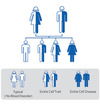Sickle Cell Anemia Flashcards
(16 cards)
What is sickle cell disease?
- Autosomal recessive disorder
- 1 in 12 African-Americans are carriers (have sickle cell trait)
- If both parents have trait, each offspring will have 1 in 4 likelihood of having disease
- Not apparent until loss of HbF. (which is about till 6months of age),

What does it mean to have sickle cell trait (genetically)?
•heterozygous with normal HbA and HbS (this on is sickled). (half normal half sickled)

What does it mean to have sickle cell anemia (genetically)?
- Sickle cell anemia- homozygous for HbS. (all sickled)
- Replacement of normal Hgb with abnormal hemoglobin S

What is the pathophysiology behind sickle cell anemia?
- Hemoglobin in the RBCs takes on an elongated “sickle” shape
- Hypoxia occurs and causes sickling
- Sickled cells are rigid and obstruct capillary blood flow
- Microscopic obstructions lead to engorgement and tissue ischemia
- Large tissue infarctions occur
- Damaged tissues in organs; impaired function

What can cause a sickle cell crisis?
- Anything that increases body’s need for oxygen or alters transport of oxygen (their cells function normally until they are under stressed)
- Trauma
- Infection, fever
- Physical and emotional stress
- Increased blood viscosity due to dehydration
-
Hypoxia
- From high altitude, poorly pressurized airplanes, hypoventilation, vasoconstriction due to hypothermia
What can cause a Vaso-occlusive [VOC] thrombotic sickle cell crisis?
- Most common type of crisis—very painful
- Stasis of blood with clumping of cells in microcirculation→ischemia→infarction
- Signs: fever, tissue engorgement, pain

What is the role of the spleen?
The body’s filter & fighter
1)Purify the blood – remove old, damaged RBCs (note: lifespan of sickle RBC = 10-20dys vs normal RBC about 120dys); removes bact from bldstrm
2)Store blood cells – produces some WBCs that fight infection & Antibodies (if spleen goes down so does their immune defenses)
What can cause Splenic sequestration thrombotic sickle cell crisis?
- Occurs when Blood pools in the spleen
-
Signs
- Profound anemia, hypovolemia, and shock
- Results in decreased immune reaction
- Life threatening—death can occur within hours
- May require splenectomy at early age
- Spleen can become inactive by age 5-6 because of the continual damage from the sickle crisis’s
What can cause aplastic crisis from a sickle cell crisis?
- Diminished production and increased destruction of RBCs
- Triggered by viral infection or depletion of folic acid
- Signs include profound anemia, pallor
What is acute chest syndrome due to sickle cell crisis and what are some symptoms?
- Presence of pulmonary infiltrate
- Clinically similar to pneumonia
-
Signs:
- Chest pain
- Coughing
- Tachypnea
- Wheezing
- Hypoxia
How would you diagnose a child with sickle cell anemia?
- Cord blood in newborns
- Newborn screening
- Genetic testing to identify carriers and children who have disease
-
Sickle turbidity test (will test for trait of sickle cell, can be carrier)
- Quick screening purposes in children
- >6 months of age
-
Hemoglobin electrophoresis (this is a diagnostic test)
- “Fingerprint” of hemoglobin protein
- Accurate & rapid
What is the prognosis for a child with sickle cell disease?
- No cure (except possibly bone marrow transplants)
- Supportive care/prevent sickling episodes
- Frequent bacterial infections may occur due to immunocompromise (no spleen = more sicknesses)
- Bacterial infection is leading cause of death in young children with sickle cell disease
- Strokes in 5% to 10% of children with disease
- Result in neurodevelopmental delay, mental retardation
What are some problems with frequent transfusions in children with sickle cell anemia?
- Frequent transfusions can lead to hemosiderosis (too much iron in tissues)
- Treat with iron chelation (iron binding to a substance) such as Deferoxamin + vitamin C to promote iron excretion (p 1431)
- Check ferattin level if you have too much iron in tissues
What are some nursing interventions for children with sickle cell disease?
- Monitor child’s growth—watch for failure to thrive (because of lack of O2
- Always watch height, weight, up until they are 2 check circumference of head. Make sure they are following the curve between the 10th-90th %tile
- Careful multisystem assessment
- Assess pain
- You can give them opiods for pain, parents are concerned that they will be addicted to it, if they are in pain they won’t get addicted, they will just have an increased tolerance.
- Observe for presence of inflammation or possible infection
- Carefully monitor for signs of shock
- •Avoid triggers of sickling- dehydration, high altitude, infections
What s/s would you report immediately for a child with sickle cell disease?
- Severe chest, back, or abdominal pain
- Fever greater than 38.3°C (101°F)
- Congested cough
- Dyspnea, tachypnea
- Retractions
- Decreasing oxygen saturation
- Severe unrelieved headaches
- Severe vomiting
- Jerking or twitching of face, legs, or arms
- Seizures
What are the signs of a CVA in relation to sickle cell disease?
- Strange abnormal behavior
- Inability to move arm and/or leg
- Stagger or an unsteady walk
- Stutter or slurred speech
- Weakness in the hands, feet or legs
- Changes in vision


